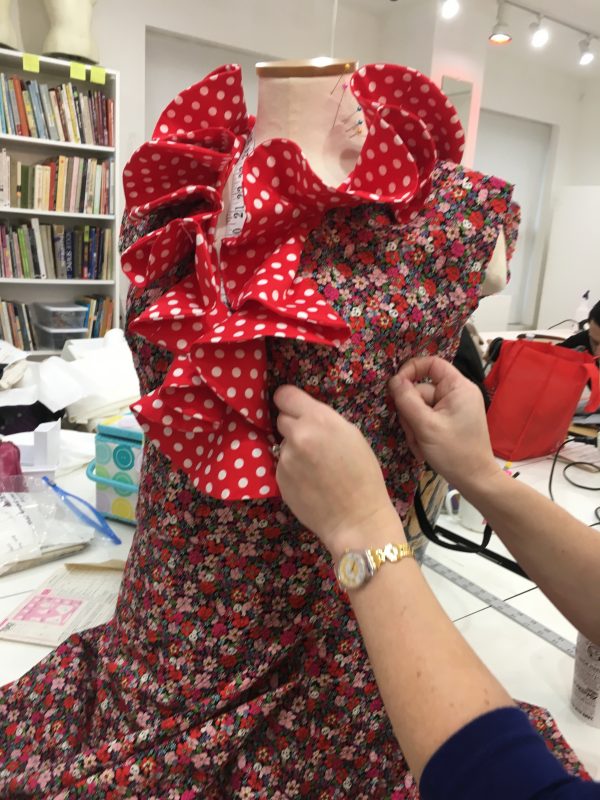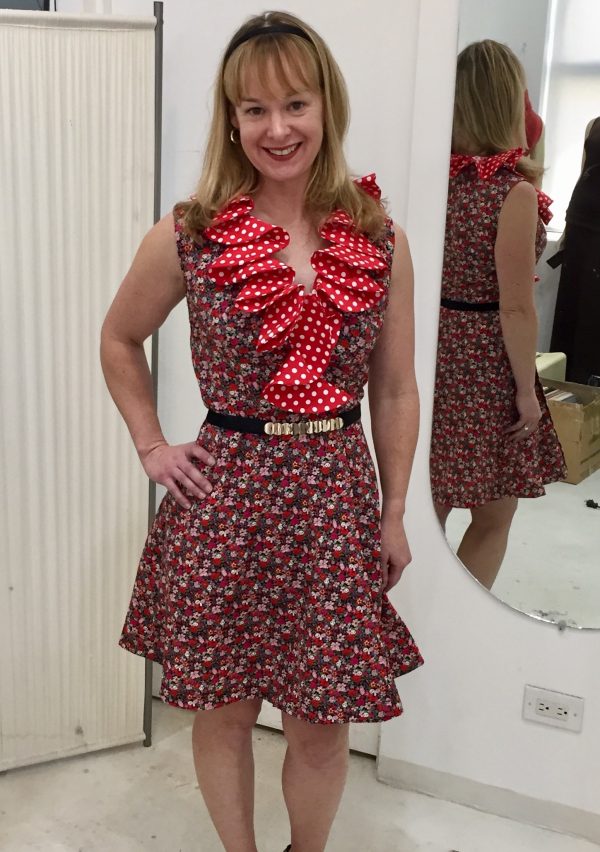Erin recently came back from a work trip in Tokyo and had a bunch of fabrics for show and tell:

There were printed knits, printed stretch bottom weights, and a few printed cottons. We settled in on this black and red floral print plissé that has a little surprise amongst the petals, sepals, leaves, and vines.
What is that surprise, you ask? One of the most delightful details ever:
We’ll write more about the importance of perspective in designing and choosing fabrics another time, but suffice to say that using a fabric like this is going to make your project more dynamic and interesting – from a distance, you see the shape and sculpture of the dress itself and otherwise register the colors and some texture. As you get closer, the shape starts to give up the secrets of the details. Up close, at just a little closer than conversational range, the pandas peek out to say “hi”. It is a nice touch that not enough people think about.
We started off with a vintage pattern that she picked up on Etsy: Simplicity #7942, a mid-to-late 1960s wrap dress with a hem set above the knee and optional sleeve and ruffle variations.

The pattern itself is a good, solid pattern recommended for stable woven fabrics, but totally adaptable to stable knits like matte jersey or double knits. The details are sharp and trued well. We’d recommend it to anyone trying to go for that mid-late 1960s look. The only thing to mention about the pattern itself is that the ruffle sections for the neckline are distinct in diameter, but very subtly so for the central ones. So make sure you mark your pieces well. They have a very gradual decrease in diameter from the back of the neck to the waist.
Other than that, great pattern. We’d recommend it again. No one over at Pattern Review has reviewed it, so if you have specific questions and are stumbling on this post, email us and we’ll be happy to help.
We knew we were going to go bold here, so she ordered some swatches from Mood for the ruffle. She was trying to decide between other plissés, a couple of flat piqués, and two different polka dot prints. She chose this red with white polka dots and we can’t help be reminded of the late 80s collections that Christian Lacroix was coming out with. Even though we didn’t discuss this initially as part of the design and construction process, there is something in the sculpture and framing of the face as well as the bold fanciful combinations of prints that speaks to us of Lacroix and the bright and luxurious fever dreams of the end of the Reagan administration.



But this is a post about Erin and her work, not a treatise on Lacroix… So let’s return…
The seams and sewing went together well. At the muslin stage we decided to drop the waistline by an inch. The pattern as-is is very much of its era – the waist is more in line with the anatomical waist like a sloper than the abdomen. If you are working this up without a muslin, you may want to add an inch to the bottom of the bodice before you cut just in case you find you want to drop it. You can always trim it off later.

Although plissé generally and this plissé in particular doesn’t have stretch per se, you may find that very precise construction details, like the points of the bust-line darts here, don’t want to lay flat because of the texture of the fabric. She went back in and ran some tiny running stitches through the end shrinking out some of the excess ease and after sewing the dart. You could try to handle this exclusively by pressing, but there is enough texture here that you may end up flattening the plissé and overworking the fabric.



And then it was hemming it up and setting the facings properly. We left this unlined but finished inside because Erin wanted something that was more Spring-Summer, but this kind of wrap dress would also adapt well to a lining.
*When you are trying to come up with cute interesting captions and headlines, sometimes you take it a little too far… e.g. for this picture we initially came up with: “Erin shows off her international booty!” and then sat for a second looking at it before we thought: “No, no, perhaps not.” Welcome to writing, folks.
